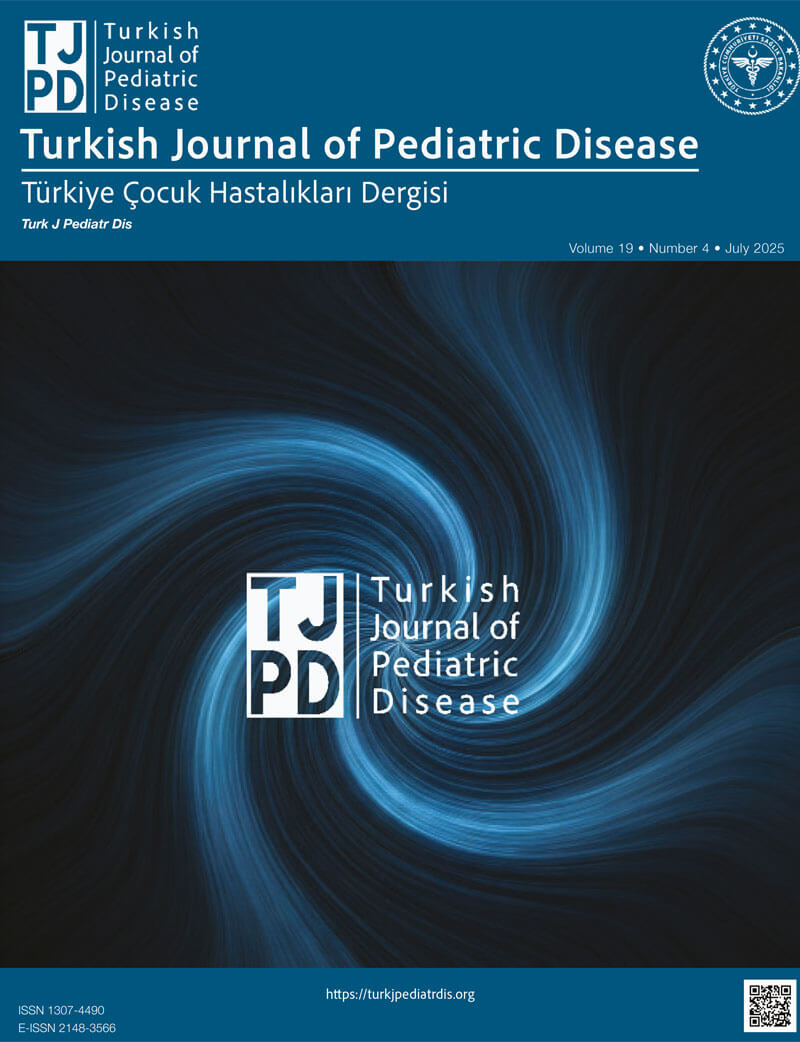Abstract
Objective: Therapeutic hypothermia is the standard neuroprotective treatment for neonates with hypoxic-ischemic encephalopathy (HIE). However, neurodevelopmental outcomes may still vary depending on the severity of encephalopathy. This study aimed to evaluate two-year neurodevelopmental outcomes in infants with HIE treated with therapeutic hypothermia and compare outcomes between Stage 2 and Stage 3 cases classified according to the Sarnat & Sarnat staging system.
Material and Methods: We conducted a retrospective cross-sectional study including 138 infants born at ≥35 weeks of gestation who were diagnosed with HIE and received therapeutic hypothermia in a Level III NICU between January 2016 and December 2017. Neurodevelopment was assessed at 24 months using the Bayley Scales of Infant and Toddler Development-II (BSID-II), focusing on Mental Development Index (MDI) and Psychomotor Development Index (PDI) scores.
Results: Infants in the Stage 3 group required significantly more respiratory support, had a higher frequency of aEEG abnormalities, and more often received anticonvulsant therapy (p=0.020, p<0.001 and p<0.001, respectively). The Stage 3 group had significantly lower mean MDI and PDI scores (84±10 and 71±11, respectively) than the Stage 2 group (89±17 and 94±18; p=0.049 and p=0.001). Neurodevelopmental impairment was more prevalent in Stage 3 patients (36.5% vs. 17.3%, p=0.012).
Conclusion: Despite uniform application of therapeutic hypothermia, neurodevelopmental outcomes at 24 months differ significantly by HIE severity. These findings highlight the importance of timely intervention, individualized follow-up, and the need for additional strategies in managing severe HIE cases.
Keywords: Hypothermia, hypoxic-ischemic encephalopathy, newborn
References
- Russ JB, Simmons R, Glass HC. Neonatal encephalopathy: beyond hypoxic-ischemic encephalopathy. Neoreviews. 2021;22(3):e148-e62. https://doi.org/10.1542/neo.22-3-e148
- Martinello K, Hart AR, Yap S, Mitra S, Robertson NJ. Management and investigation of neonatal encephalopathy: 2017 update. Arch Dis Child Fetal Neonatal Ed. 2017;102(4):F346-F58. https://doi.org/10.1136/archdischild-2015-309639
- Tierradentro-García LO, Saade-Lemus S, Freeman C, Kirschen M, Huang H, Vossough A, et al. Cerebral blood flow of the neonatal brain after hypoxic-ischemic injury. A J perinatol. 2023;40(05):475-88. https://doi.org/10.1055/s-0041-1731278
- Akisu M, Kumral A, Canpolat FE. Turkish Neonatal Society Guideline on neonatal encephalopathy. Turk Pediatri Ars. 2018;53(Suppl 1):S32-S44. https://doi.org/10.5152/TurkPediatriArs.2018.01805
- Sandoval Karamian AG, Mercimek-Andrews S, Mohammad K, Molloy EJ, Chang T, Chau V, et al. Neonatal encephalopathy: Etiologies other than hypoxic-ischemic encephalopathy. Semin Fetal Neonatal Med. 2021;26(5):101272. https://doi.org/10.1016/j.siny.2021.101272
- Cornet M-C, Kuzniewicz M, Scheffler A, Forquer H, Hamilton E, Newman TB, et al. Perinatal hypoxic-ischemic encephalopathy: incidence over time within a modern US birth cohort. Pediatr Neurol. 2023;149:145-50. https://doi.org/10.1016/j.pediatrneurol.2023.08.037
- Ristovska S, Stomnaroska O, Danilovski D. Hypoxic Ischemic Encephalopathy (HIE) in Term and Preterm Infants. Pril (Makedon Akad Nauk Umet Odd Med Nauki). 2022;43(1):77-84. https://doi.org/10.2478/prilozi-2022-0013
- Pisani F, Fusco C, Nagarajan L, Spagnoli C. Acute symptomatic neonatal seizures, brain injury, and long-term outcome: the role of neuroprotective strategies. Expert Rev Neurother. 2021;21(2):189-203. https://doi.org/10.1080/14737175.2021.1848547
- Park J, Park SH, Kim C, Yoon SJ, Lim JH, Han JH, et al. Growth and developmental outcomes of infants with hypoxic ischemic encephalopathy. Sci Rep. 2023;13(1):23100. https://doi.org/10.1038/s41598-023-50187-0
- Lee BL, Glass HC. Cognitive outcomes in late childhood and adolescence of neonatal hypoxic-ischemic encephalopathy. Clin Exp Pediatr. 2021;64(12):608. https://doi.org/10.3345/cep.2021.00164
- Trivedi SB, Vesoulis ZA, Rao R, Liao SM, Shimony JS, McKinstry RC, et al. A validated clinical MRI injury scoring system in neonatal hypoxic-ischemic encephalopathy. Pediatric Radiol. 2017;47:1491-9. https://doi.org/10.1007/s00247-017-3893-y
- Perez JMR, Golombek SG, Sola A. Clinical hypoxic-ischemic encephalopathy score of the Iberoamerican Society of Neonatology (Siben): a new proposal for diagnosis and management. Rev Assoc Méd Bras. 2017;63(1):64-9. https://doi.org/10.1590/1806-9282.63.01.64
- Mendler MR, Mendler I, Hassan MA, Mayer B, Bode H, Hummler HD. Predictive value of Thompson-score for long-term neurological and cognitive outcome in term newborns with perinatal asphyxia and hypoxic-ischemic encephalopathy undergoing controlled hypothermia treatment. Neonatology. 2018;114(4):341-7. https://doi.org/10.1159/000490721
- Sarnat HB, Flores-Sarnat L, Fajardo C, Leijser LM, Wusthoff C, Mohammad K. Sarnat grading scale for neonatal encephalopathy after 45 years: an update proposal. Pediatr Neurol. 2020;113:75-9. https://doi.org/10.1016/j.pediatrneurol.2020.08.014
- Proietti J, Boylan GB, Walsh BH. Regional variability in therapeutic hypothermia eligibility criteria for neonatal hypoxic-ischemic encephalopathy. Pediatr Res. 2024;96(5):1153-61. https://doi.org/10.1038/s41390-024-03184-6
- Bayley N. Bayley-III: Bayley Scales of infant and toddler development: Giunti OS Florence, Italy; 2009.
- Bayley N. Manual fort he Bayley Scales of Infant Development. 2nd ed. San Antonio, TX: The Psychological Corporation; 1993.
- Goswami I, Guillot M, Tam EW, editors. Predictors of long-term neurodevelopmental outcome of hypoxic-ischemic encephalopathy treated with therapeutic hypothermia. Semin Neurol. 2020;40(3):322-34. https://doi.org/10.1055/s-0040-1702939
- Cainelli E, Vedovelli L, Mastretta E, Gregori D, Suppiej A, Bisiacchi PS. Long-term outcomes after neonatal hypoxic-ischemic encephalopathy in the era of therapeutic hypothermia: a longitudinal, prospective, multicenter case-control study in children without overt brain damage. Children. 2021;8(11):1076. https://doi.org/10.3390/children8111076
- Çelik P. Hipoksik İskemik Ensefalopati Nedeniyle Terapötik Hipotermi Uygulanan Bebeklerin Nörogelişimsel Sonuçları. Turkish J Pediatr Dis. 2021;15(5):359-64. https://doi.org/10.12956/tchd.788065
- Edmonds CJ, Helps SK, Hart D, Zatorska A, Gupta N, Cianfaglione R, et al. Minor neurological signs and behavioural function at age 2 years in neonatal hypoxic ischaemic encephalopathy (HIE). Eur J Paediatr Neurol. 2020;27:78-85. https://doi.org/10.1016/j.ejpn.2020.04.003
- Al Amrani F, Kwan S, Gilbert G, Saint-Martin C, Shevell M, Wintermark P. Early Imaging and Adverse Neurodevelopmental Outcome in Asphyxiated Newborns Treated With Hypothermia. Pediatr Neurol. 2017;73:20-7. https://doi.org/10.1016/j.pediatrneurol.2017.04.025
- Jary S, Whitelaw A, Walløe L, Thoresen M. Comparison of Bayley-2 and Bayley-3 scores at 18 months in term infants following neonatal encephalopathy and therapeutic hypothermia. Dev Med Child Neurol. 2013;55(11):1053-9. https://doi.org/10.1111/dmcn.12208
- Moore T, Johnson S, Haider S, Hennessy E, Marlow N. Relationship between test scores using the second and third editions of the Bayley Scales in extremely preterm children. J Pediatr. 2012;160(4):553-8. https://doi.org/10.1016/j.jpeds.2011.09.047
- Çelik P, Sucakli IA, Yakut HI. Which Bayley-III cut-off values should be used in different developmental levels? Turk J Med Sci. 2020;50(4):764-70. https://doi.org/10.3906/sag-1910-69
Copyright and license
Copyright © 2025 The Author(s). This is an open access article distributed under the Creative Commons Attribution License (CC BY), which permits unrestricted use, distribution, and reproduction in any medium or format, provided the original work is properly cited.






